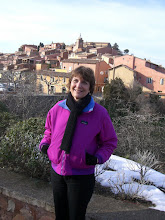
Since we still had the car last Monday, we decided to go see another of the big towns of the Vaucluse: Orange. The area has undergone tremendous transformations and hardships over the centuries. Originally settled by the Gauls, it became a Roman colony around the year 35 BCE. The city went on to be attacked and partially destroyed by the Visigoths in the fifth century. Its population was decimated by la peste (“the plague”) in 1348 and again in 1720. In the sixteenth century the locale was settled by the Dutch whose ruling family is still named “the Royal House of Orange.” But today this city of about 30,000 people, known as having one of the warmest climates in France, is relatively quiet, yet proud of its heritage.

During Pax Romana, the time of peace and prosperity with the Gauls, the Romans created many buildings in the colony that they referred to as Arausio. There is an Arc de Triomphe on the outskirts of town, which is presently undergoing restoration. However, the crowning achievement of Roman architecture in the city is the antique theater. For a small fee, visitors can take a self-guided tour with audiophones of this 1st century structure built during the reign of Augustus. The theater has one of the best conserved murs de scène (“stage walls”) in the world; according to our audioguide only in Syria and Turkey could you also find such an impressive relic from Roman times. The sight of it in the seventeenth century prompted King Louis XIV to exclaim: « C’est la plus belle muraille de mon royaume. » ("It's the most beautiful wall in my kingdom.")
 The theater, we learned, used to have statues in all of its niches (like the one of Augustus in the picture), as well as marble facing on the walls, several rows of columns, and mosaics decorating it. The sitting area, called the cavea, provided room for about 8000-10000 spectators, seated according to their status in society. The orchestra, in a semicircle on the ground, had room for movable seats for the highest-ranking dignitaries; on the uppermost tiers sat prostitutes and beggars. All of the presentations were free of charge and a kind of tarp, a velum, stretched across the top of the theater to protect spectators from the sun. After the so-called “barbarian invasions” and the 16th century wars of religion, the theater fell into disrepair; houses were even constructed inside it. But thanks to author Prosper Merimée, a restoration project was launched in 1825. Only the first three rows of seats are original and in 2006 a small glass and metal roof was added to protect the stage wall and to add lighting. The theater was placed on the list of World Heritage Sights by UNESCO. International music festivals, currently called Les Nouvelles Chorégies, have been presenting symphonies and operas every summer since 1869. Plays have been staged there as well; Sarah Bernhardt, for example, performed the role of Racine’s Phèdre at the theater in 1903. The day we were there several groups of young people were trying out the theater’s great acoustics by reading to their friends who were in the upper part of the stands.
The theater, we learned, used to have statues in all of its niches (like the one of Augustus in the picture), as well as marble facing on the walls, several rows of columns, and mosaics decorating it. The sitting area, called the cavea, provided room for about 8000-10000 spectators, seated according to their status in society. The orchestra, in a semicircle on the ground, had room for movable seats for the highest-ranking dignitaries; on the uppermost tiers sat prostitutes and beggars. All of the presentations were free of charge and a kind of tarp, a velum, stretched across the top of the theater to protect spectators from the sun. After the so-called “barbarian invasions” and the 16th century wars of religion, the theater fell into disrepair; houses were even constructed inside it. But thanks to author Prosper Merimée, a restoration project was launched in 1825. Only the first three rows of seats are original and in 2006 a small glass and metal roof was added to protect the stage wall and to add lighting. The theater was placed on the list of World Heritage Sights by UNESCO. International music festivals, currently called Les Nouvelles Chorégies, have been presenting symphonies and operas every summer since 1869. Plays have been staged there as well; Sarah Bernhardt, for example, performed the role of Racine’s Phèdre at the theater in 1903. The day we were there several groups of young people were trying out the theater’s great acoustics by reading to their friends who were in the upper part of the stands.

No comments:
Post a Comment